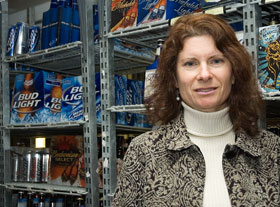  |
| HOME | THIS ISSUE | CALENDAR | GRANTS | BACK ISSUES | < BACK | NEXT > |
Teenagers exposed to alcohol ads drink more, study findsby Beth Krane - January 23, 2006
|
||||
|
The more money the alcohol industry spends on advertising, the more young people drink, according to a new UConn study published in the Jan. 3 issue of the Archives of Pediatric and Adolescent Medicine. “We found that alcohol advertising contributes to significant increases in youth drinking,” says Leslie Snyder, professor of communication sciences and lead author of the study. “The number of ads youth see matters. Living in a media market with many ads matters.” While other researchers have used local or aggregate studies to determine whether a relationship exists between alcohol advertising and youth drinking, Snyder and her colleagues at UConn and Ohio State University provide the first national, longitudinal look at the issue. “This is the most solid piece of research evidence to come forth to date linking exposure to alcohol advertising to increased youth drinking,” says David Jernigan, executive director of Georgetown University’s Center on Alcohol Marketing and Youth, who wrote an editorial accompanying the study in the Archives of Pediatric and Adolescent Medicine. The study garnered both national and international media attention, including a story by Reuters that was widely picked up, and interviews on National Public Radio’s “All Things Considered” and BBC radio. Among the study’s key findings:
As part of the study, the researchers also examined the alcohol ad exposures and drinking behaviors of only those youths ages 15 to 21 and found little difference between their behaviors and those of the larger sample of youths, ages 15 to 26. The National Institute on Alcohol Abuse and Alcoholism, which funded the study, has identified underage and youth drinking as “an enormous public health problem in the United States,” citing a host of adverse short-term and long-term effects. Among them: alterations in brain development, poor academic performance, risky sexual behavior, increased likelihood of alcohol addiction, and increased likelihood of fatal alcohol-related accidents, including car crashes. Snyder and her colleagues conducted the study to address a long-standing debate whether young people drink more because of alcohol advertising, or young people who drink more simply pay more attention to alcohol advertisements.
“This study provides an important perspective on that hotly contested question, because we used an objective measure of the presence of alcohol advertising – the amount of alcohol advertising dollars spent per capita in each media market – in addition to young people’s recollections of seeing ads,” says Snyder, who also directs the UConn Center for Health Communication and Health Marketing. “We then showed a link between both advertising spending and remembering ads with young people’s reports on how much they drank.” Snyder and her colleagues also controlled for total alcohol sales and consumption in each market. Snyder said the study’s findings are significant because they suggest that public health officials and policy makers hoping to reduce youth drinking must address alcohol advertisements as part of their overall strategy. “Policy options could include reducing the number of ads young people see by establishing limits on when and where alcohol ads can be placed, changing the contents of the ads themselves to lessen their effect on youth, and countering alcohol advertising with well-funded public health campaigns to reduce youth drinking, as was done with tobacco,” Snyder says. The alcohol industry is not subject to federal restrictions on its advertising practices, but does have voluntary advertising codes created by major alcohol trade groups. About the Study: A random sample of youths ages 15 to 26 from 24 Nielsen media markets were interviewed over the telephone four times over the course of 21 months. The 24 media markets were selected to be representative of the 75 largest media markets in the country when viewed as a whole. The sample sizes per wave were 1,872, 1,173, 787, and 588, with the mobility of youths ages 18 to 26 contributing to sample attrition. The youths interviewed were asked three questions about their alcohol consumption to determine the frequency of their drinking, the average quantity of alcohol consumed, and the maximum quantities of alcohol consumed. They also were asked eight questions about their exposure to alcohol advertisements. Industry data on the amount of money spent on alcohol advertisements on television, radio, newspaper, and outdoors (mostly billboards) also were used for each of the media markets studied. For more information about the study and Jernigan’s accompanying editorial in the Archives of Pediatric and Adolescent Medicine, log on to http://archpedi.ama-assn.org/. For more information on alcohol advertising spending in a particular media market, visit http://www.tns-mi.com/. |
| ADVANCE HOME UCONN HOME |

